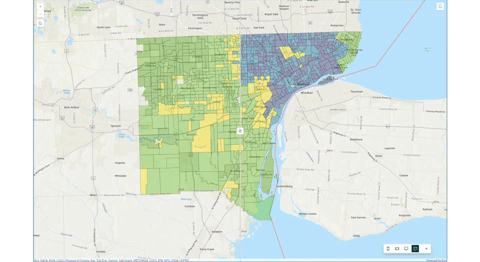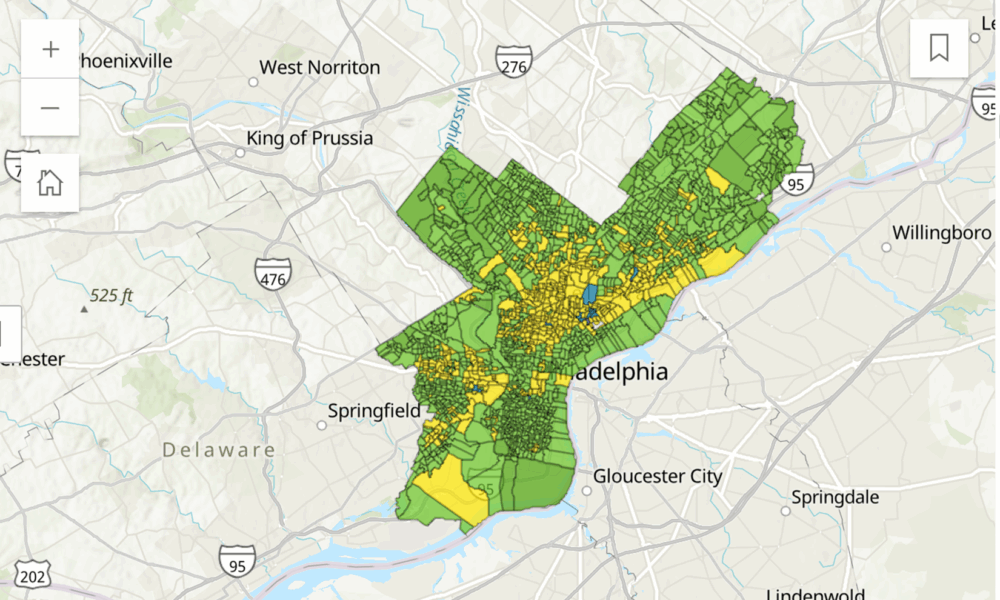Today, the Union of Concerned Scientists released a new report, Blocked from the Ballot Box: Structural Obstacles Depress Turnout, Exacerbate Ballot Rejections Across Racial Lines. Along with this report, we’ve released two interactive maps that illustrate our report’s findings. In this post, you’ll learn how to explore these maps and what implications our findings have for future elections.
Explore voter turnout and racial demographics in communities
Our analysis finds that turnout in our sample of battleground counties was highest in majority-White precincts in both 2020 and 2024. In the 2020 election, majority-White precincts had an average of nearly 81 percent turnout while majority-Black (about 62 percent) and majority-Hispanic (about 56 percent) had considerably lower rates.
In 2024, we found a similar pattern—majority-White precincts had an average turnout rate of about 75 percent, while majority-Black and majority-Hispanic precincts had average rates around 50 and 53 percent, respectively.
You can take a deeper dive into our data by exploring the first interactive map displaying 2020 and 2024 precinct-level voter turnout in 11 counties across seven battleground states.
Using the mapping tool is simple. The map view starts on Wayne County, Michigan but you can move the map to the ten other featured counties by clicking on the bookmark icon at the top right of the map and selecting another location from the drop-down menu, or by zooming in and out.
The left side of the slider shows 2020 precinct-level voter turnout data, while the right side shows 2024 voter turnout. Click on any precinct to see the percentage of registered voters who voted in the respective election, as well as the estimated majority race of the precinct according to Census data. Each precinct is color coded from dark blue (0-20 percent of registered voters voted in 2020 or 2024) to dark green (81-100 percent).
One of the most interesting elements of our map is the ability to explore individual precincts. For example, we can take a closer look at Wayne County, Michigan.

In 2020, Wayne County ranked among the lowest of the 11 counties by turnout in our analysis, with an average 62.72 percent turnout, and had the lowest turnout in 2024 at 44.45 percent. In the GIF above, you can see that turnout in both years is generally lower in the heart of the city of Detroit and increases farther out as communities become more suburban. In 2024, for example, turnout rates in Detroit averaged about 20 percent in most precincts. Moreover, Wayne County’s official canvass report only reported ballots cast on Election Day and not those cast early or absentee for precincts in Detroit, further illustrating issues with data completeness and uniformity.
By clicking one of the precincts near the city center, a pop-up will appear. In Precinct 127, a majority-Black precinct in the heart of Detroit in the Lower East Central area, 40 percent of registered voters voted in 2020. In 2024 precinct numbers had changed, but Precinct 125 which was in the same general region as Precinct 127 in 2020, had a turnout rate of 19 percent (the fact that precincts change from one election to the next is one of the many things that make our kind of analysis difficult).
However, in Precinct 001—a majority-White suburb of Detroit in the Grosse Pointe Park area about 5 miles east of Precinct 127—82 percent of registered voters turned out in 2020. In 2024, 77 percent of registered voters turned out.
These disparities between precincts of different racial demographics result in significant under-representation of communities of color. Consequently, these same communities are less likely to have their interests, needs, and preferences reflected in the decisions made by elected officials, leading to policies that often fail to protect their health, safety, and well-being.
Explore ballot rejection rates and racial demographics
The second interactive map shows 2020 and 2024 precinct-level ballot rejection rates. In 2020, rejection data are available for 8 of the 11 counties. In 2024, however, we were only able to obtain rejection rates for three counties. As a result, one side of the map will appear blank for counties where data are available for a single year. Election administrators face numerous barriers to collect, secure, and share these data. The absence of rejection data for most of our sample counties in 2024 underscores the widespread inaccessibility of comprehensive precinct-level data and the importance of our work to improve election data transparency. Check out this post by guest blogger and report co-author Rose Nafa on election data transparency.
In each of the counties where data was available, precincts are divided into thirds based on the percentage of total ballots cast that were rejected. High rejection precincts (those that reject a comparatively higher percentage of ballots than other precincts in the county) are blue, medium rejection precincts are yellow, and low rejection precincts (those that rejected comparatively fewer ballots compared to other precincts in the county) are green.

Ideally, precincts should have low rejection rates, meaning that more voters were able to successfully have their votes counted. However, our analysis found that voters living in low-turnout precincts, which are disproportionately majority-people of color, were more likely to have their provisional or absentee ballots rejected in 2020 and 2024. These disparities further increase racial inequities in our elections.
What this means for future elections
Bad actors are already trying to suppress votes and redraw maps ahead of the 2026 midterm elections, which could exacerbate existing inequality. What’s more, these attacks on the voting process are based on misinformation about large-scale irregularities that our analysis shows simply aren’t real. Our precinct-level maps of battleground counties from recent presidential elections rebut the lies that are used to justify vote suppression and demonstrate the real barriers to free and fair elections. They can also help community organizations and election administrators determine where voters in their community need more directed voter education and targeted GOTV efforts.
Now you’re ready to use the map! You can also read the report here or my blog post with a deeper dive into the report results here.

